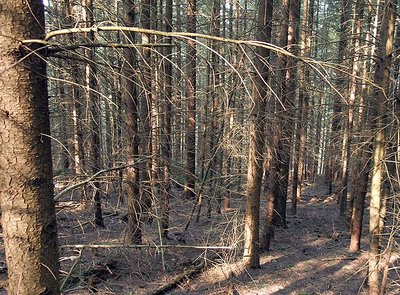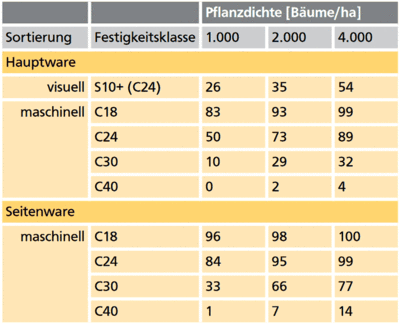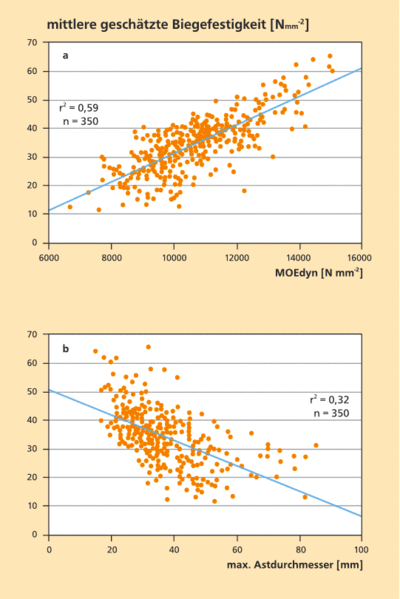Physical and mechanical properties are important for the use of building materials in construction. As it is a naturally grown raw material, the properties of timber vary - but structural engineers, architects and timber users need constant, defined timber properties. The sorting of the timber should guarantee these timber properties.
A research project conducted by the Technical University of Munich has improved our knowledge of the growth and timber quality of individual trees and stands of young Douglas firs. The focus of the analysis was on the effect of stand density on the quality of sawn timber. The project also investigated how an early filtering of the flow of round timber can increase the sawn wood yield.
Materials and methods
On two experimental areas in the Unterfranken (HE) and Mittelfranken regions (AN), 40-year-old Douglas firs (167 trees) were harvested in the course of a thinning measure. The planting densities were 1.000, 2.000 and 4.000 trees per hectare. The short-wood logs harvested (Tab. 1) were cut to 4.1 metre lengths and sorted mechanically, before an assessment was made of their wood engineering properties.
Silvicultural measures improve the properties of sawn timber
The quality of square edge timber, boards and planks is evaluated depending on their knots, raw density, stiffness and strength, and the timber is then also sorted on the basis of these characteristics. The results of the project show that the closer together the trees are planted, the better the strength-related properties of the sawn timber. A significant difference in the knots, elasticity and strength of sawn timber was particularly clear in the comparisons of planting densities of 1.000 and 2.000 trees per hectare, and of 1.000 and 4.000 trees per hectare. The improvement in quality with increasing planting density is manifested in terms of increasing yield. The side-cut timber is also more valuable than the principal product (Tab. 2), because with increasing distance from the core of the tree, there are fewer knots and a higher raw density.
Different methods for sorting
Douglas fir timber will continue to be used mainly in the form of sawn timber. Apart from the appearance of the sawn timber, its strength and stiffness are crucial for its use in the building industry, because construction timber must be available on the market in specific, reliable qualities. Sorting guarantees values that vary only within narrow margins. Sawn timber can be visually or mechanically sorted for strength and allocated to particular grade or strength classes. With mechanical sorting, higher classes and also higher yields can be achieved than with visual sorting.
The sawn timber quality can be judged by using a suitable mechanical method to sort the roundwood, or by assessing the standing tree. The dynamic elasticity module (MOEdyn) of the short-wood logs correlates closely with the strength of the square-edged sawn timber and boards cut from them; if the roundwood is sorted visually, the maximum branch diameter also correlates well with the properties of the sawn timber (Fig. 2). Throughout the processing chain there are thus both classical and modern methods available for evaluating the timber quality, and this facilitates the efficient steering of the flow of roundwood and sawn timber, i.e. the allocation of timber to the appropriate use for the quality. The accuracy of the quality assessment improves over the course of the processing; at the beginning of the process there are however more possibilities open for the handling of the timber.
Consequences for the forestry and timber industries
The study shows the influence of silviculture on the potential use of Douglas fir timber. High planting densities produce a high quality of sawn timber. This is also likely to be true for spruce and other conifers. It is essential to know this in order to find the optimum balance between stand stability, usable timber quantities and ecological value. The study emphasises the technological qualities of the timber and provides valuable knowledge in the discussion on appropriate plant numbers and the optimum spacing of the trees. From the point of view of the wood’s technological properties, the quality improves particularly where the planting density is increased from 1.000 to 2.000 trees per hectare.
Quality is measurable and visually apparent at the tree, roundwood and sawn timber levels. The timber quality could thus be given more weight in the evaluation of roundwood. Sawmills benefit from the better roundwood, achieve higher strength classes (Tab. 2), and can thus pay more for roundwood of higher quality. In practice today, however, roundwood is evaluated mainly on the basis of its volume, not on the basis of timber quality. The quality assessment can be improved by assessing the short-wood logs - assuming complete and transparent traceability - or the (wet) sawn wood. An early assessment of quality in the production chain opens lots of options for handling the timber and can help allocate the sorted material to the optimum use.
The results are based on experiments carried out on 40-year-old Douglas firs, i.e. classical thinning trees. Final crop trees are not included in the sample. It is to be expected that the quality of older Douglas firs is higher than that of thinning trees because of the low proportion of juvenile wood and because the quality of the timber increases with distance from the core of the tree (natural reduction in knots, higher raw density). Because of the greater yield from the side-cuts (Tab. 2), a high initial planting density presumably also improves the timber quality of thicker trees.






![[Translate to English:] [Translate to English:]](/assets/_processed_/6/c/csm_fva_douglasienholz_2_e31f8d540d.jpeg)